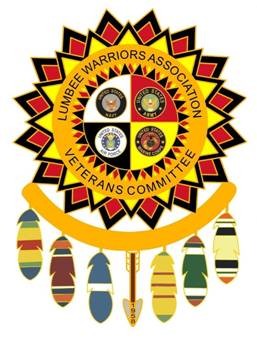
Lumbee Tribe Veterans Honored for their Service and Dedication.
The Lumbee Tribe of North Carolina is a state recognized tribe of approximately 55,000 enrolled members, most of them living in Robeson and the adjacent counties in southeastern North Carolina. The Lumbee Tribe was recognized by the US Congress in 1956 but was not given access to federal funds set aside for Indian tribes. According to the 2000 US Census report, the population of the town of Pembroke, North Carolina, is 89% Lumbee Indian and that of the county is nearly 40% Lumbee.
The Lumbee are one of eight state-recognized Native American tribes in North Carolina; they have been recognized by the state since 1885. They participate at the state level in many ways, including in the North Carolina Commission of Indian Affairs. They also participate in such national organizations as the National Congress of American Indians and the National Indian Education Association.
During the 1950s, the Lumbee made nationwide news when they came into conflict with the Knights of the Ku Klux Klan, a white supremacist organization headed by Klan Grand Dragon James W. "Catfish" Cole. Cole began a campaign of harassment against the Lumbee, claiming they were "mongrels and half-breeds" whose "race mixing" threatened to upset the established order of segregated Jim Crow South.[citation needed] After giving a series of speeches denouncing the "loose morals" of Lumbee women, Cole burned a cross in the front yard of a Lumbee woman in St. Pauls, North Carolina, as a "warning" against "race mixing."[citation needed] Emboldened, Cole called for a Klan rally on January 18, 1958, near the town of Maxton. The Lumbee, led by recent veterans of the Second World War, decided to disrupt the rally.
The "Battle of Hayes Pond", also known as "the Klan Rout", made national news. Although Cole had predicted over 5,000 Klansmen would show up for the rally, less than 100 and possibly as few as three dozen attended. Approximately 500 Lumbee, armed with guns and sticks, gathered in a nearby swamp, and when they realized they possessed an overwhelming numerical advantage, attacked the Klansmen. The Lumbee encircled the Klansmen, opening gunfire and wounding four Klansmen in the first volley, none seriously. The remaining Klansmen panicked and fled. Cole was found in the swamps, arrested and tried for inciting a riot. The Lumbee celebrated the victory by burning Klan regalia and dancing around the open flames. The Battle of Hayes Pond, which marked the end of Klan activity in Robeson County, is celebrated as a Lumbee holiday.
The Lumbee Act, also known as H.R. 4656 (Pub.L. 84–570, 70 Stat. 254), passed by Congress in late May 1956 as a concession to political lobbying and signed by President Dwight David Eisenhower, designated the Lumbee as an Indian people. It withheld full recognition as a "Tribe", as agreed to by the Lumbee leaders. The Lumbee Act designated the Indians of Robeson, Hoke, Scotland, and Cumberland counties as the "Lumbee Indians of North Carolina. "as requested by the Lumbee HR 4656 stipulated that "[n]othing in this Act shall make such Indians eligible for any services performed by the United States for Indians because of their status as Indians." It also forbids a Government relationship with the Lumbees and forbids them from applying through the BARS, B.I.A. process for recognition. This restriction as to eligibility for services was a condition which tribal representatives agreed to at the time in order to achieve the name for their group. The Lumbee assimilated into early colonial life prior to the formation of the United States. They lived the same as any other colonial and U.S. citizens as individuals. Lumbee spokesmen repeatedly testified that they were not seeking financial services; they said they only wanted a name designation as Lumbee people.
Today the Lumbee primarily practice Christianity, and attending church is an important social activity. Churches have Sunday schools, youth organizations, senior citizens' programs, Bible study programs, and choir practices. Gospel songs are popular. Ministers are highly respected. When a sizeable number of Lumbee people move to a city, they tend to settle in a particular section or neighborhood and establish a church. This took place in Lumbee communities in Baltimore, Greensboro, Fayetteville, Charlotte, and Claxton, Georgia.
A study documented Lumbee Methodism back to 1787. Lumbees created two church conferences of Indian congregations: the Burnt Swamp Baptist Association, founded around 1880, and the Lumbee River Conference of the Holiness Methodist Association in 1900. In 1984 Bruce Barton documented 104 Lumbee churches. Prospect Methodist Church, with 603 members in 1990, has purportedly the largest congregation of Native Americans in the United States.*
*https://en.wikipedia.org/wiki/Lumbee
KAN
Kin 44: Yellow Overtone Seed
I empower in order to target
Commanding awareness
I seal the input of flowering
With the overtone tone of radiance
I am guided by the power of free will.
Cosmic Ascension refers to mastery of higher powers of telepathic perception and projection; this means we can perceive ourselves anywhere in the universe project to those places as necessary.*
*Star Traveler's 13 Moon Almanac of Synchronicity, Galactic Research Institute, Law of Time Press, Ashland, Oregon, 2016-2017.
The Sacred Tzolk'in
Muladhara Chakra (Seli Plasma)




No comments:
Post a Comment